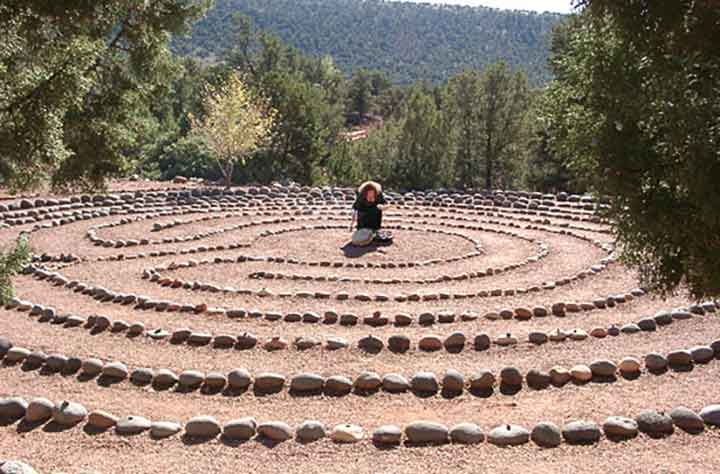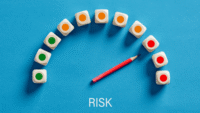Does your job have you running around in circles? Are you super-stressed out, but too jittery to ease your tension with a sitting meditation? Then maybe it’s time you tried a labyrinth. No I’m not suggesting you imitate a rat in a maze. A labyrinth, unlike a maze, has no dead ends, blind passages, or wrong turns to frustrate you. Being in one is usually soothing, like a walking meditation.
A single path, a serene setting
A labyrinth has a single path winding toward the center, which is visible anywhere from the circuit’s perimeter. Each step takes you closer to its center.
Representing growth and transformation, a labyrinth can confer a sense of clarity, peace, and serenity. Psychotherapist Melissa West, author of Exploring the Labyrinth: A Guide for Healing and Spiritual Growth, describes the labyrinth experience as walking toward one’s own core and the center of one’s soul. Rev. Dr. Lauren Artress calls a labyrinth a watering hole for the spirit and a mirror of the soul.
West shows her clients how walking a labyrinth can reconnect them to their souls. She believes a labyrinth can teach them about their feet, breath, and heart and the rhythm of their souls. For many people, she says, a labyrinth walk leads to personal revelations. Some walkers identify the twists, turns, and center of the labyrinth with the twists, turns, and center of their own lives.
Labyrinth proponents claim walking a labyrinth can lead to deeper relationships, a stronger sense of community, a feeling of being on a spiritual journey, a sense of inner reflection and connection to sources of guidance, a sense of living in the present, greater creativity, and stress reduction. (See Benefits of walking a labyrinth by clicking on the PDF icon above.)
History of the labyrinth
Labyrinths have been around since ancient times. During the Middle Ages, nearly 25% of cathedrals had them. Today, you can find labyrinths in many sites medical centers, spas, parks, schools, prisons, playgrounds, retreat centers, and even people’s backyards. (See Finding a labyrinth near you by clicking on the PDF icon above.)
Preparing for the walk
There is no right or wrong way to walk a labyrinth, but experts offer guidelines. Helen Curry, author of Way of the Labyrinth, recommends that you focus your attention inward, set an intention, choose a specific meditation or mantra, and recognize your personal feelings. An intention is a question or statement that a person in search of guidance sends to the universe. It might be a prayer, or it might be a statement about a particular feeling or emotion, a relationship or spiritual issue, or a particular event. Examples include:
“I am open to receiving guidance about”
Where do I need more clarity in my life?
Using a specific meditation or mantra can help unclutter your mind as you walk. Examples include reciting Bible verses or children’s songs, and chanting. Typically, the walker repeats the verse, song, or chant during the walk. Curry recommends a rhythmic meditation or mantra that aligns with one’s intention.
Walking the walk
In a labyrinth, let your walk unfold on its own. Don’t try to make something happen. If you are seeking a more structured experience, Artress identifies three stages of walking the labyrinth:
- Stage 1: Releasing. As you start your journey toward the center of the labyrinth, begin to release your thoughts and concerns.
- Stage 2: Receiving. When you reach the center, stay there as long as you wish, meditating.
- Stage 3: Returning. Once you return from the center and leave the labyrinth, you are ready to integrate back into everyday life with heightened spiritual awareness.
- Whether you walk a labyrinth for stress reduction, problem-solving, or spiritual transformation, remember that there is no right or wrong way to journey on this path. The opportunities and possibilities are endless.Selected referencesCurry H. The Way of the Labyrinth. New York, NY: Penguin Compass; 2000.
Freeman VL. One path with many turns. Altern Med. 2005;80:43-49.Sandor MK, Froman MD. Exploring the effects of walking the labyrinth. J Holist Nurs. 2006;24(2):103-109. http://jhn.sagepub.com/cgi/content/abstract/24/2/103. Accessed June 24, 2008.
Visit www.AmericanNurseToday.com for a complete list of selected references.Mary V. Shindle is Professional Development Coordinator at City Hospital (part of West Virginia University Hospital East) in Martinsburg.



















2 Comments.
gave up my decades long job and bought a bush block for my partner and i with our tribe of rescue dogs to get away from society and chase peace and tranquility. we have built a couple of dwellings (one a home, another for storage, and a hobbit house for play) and we are currently clearing more land and designing and creating our own labyrinth with an eye to healing my anxiety grief and depression with daily use. thankyou for your informative article. it reconfirmed my hopes that this will be what i have been searching for.
This is an excellent article. Learned some about meditation. Thank you!